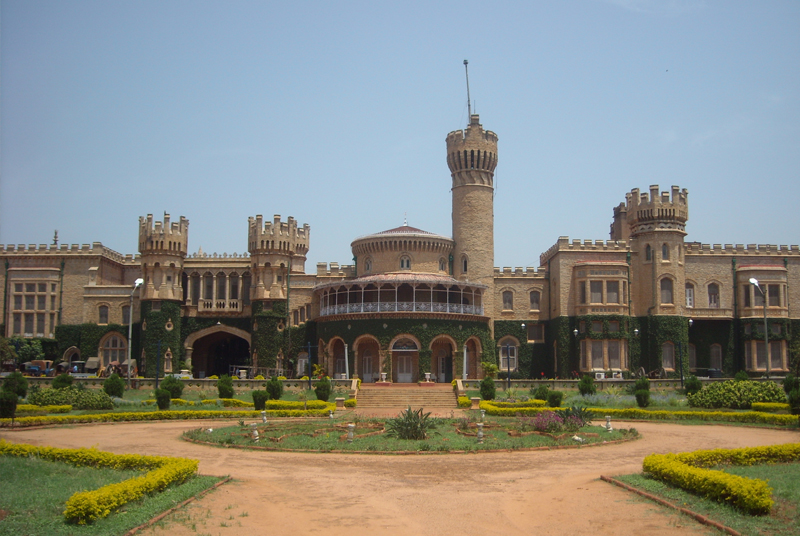About
In the midst of the hustle and bustle of the electronic city of Bengaluru, Karnataka, lies the majestic Bengaluru Palace. Enclosed by beautiful gardens, this palace not only attracts tourists in large numbers, but is also a preferred destination for important events and cultural programs. The wooden structure of the palace, with splendid carvings both inside and outside depicting different architectural styles, is reminiscent of the royal culture it represents.
History and Architecture
Rev. Garrett, the principal of the Central High School in Bengaluru, started construction of the palace in 1862, which was completed in 1944. The ownership of the palace changed hands several times, from the Reverend to Chamarajendra Wadiyar of the Wadiyar Dynasty, to the British Empire. One version of the history says that on one of his trips to England, Chamarajendra Wadiyar was quite enchanted with the Windsor Castle, and that this inspired him to build the Bengaluru Palace in the Tudor architectural style. However, the audio tour of the palace has no mention of the Castle. Presently, Bangalore Palace is under the ownership of the descendant of the Mysore Royal Family, Srikanta Datta Narasimharaja Wadiyar. He opened the palace in 2005 for public viewing. The entry fees and other charges so collected are used for the maintenance and upkeep of the palace.
The Wadiyars were believed to be great hunters, and Jayachamaraja Wadiyar was considered to have hunted around 300 tigers and several elephants. One such elephant head is mounted at the entrance of the palace. Stools made of elephant feet, vases of the elephant trunk, and trophies of elephant hunting are displayed in the palace.
The palace complex, including the gardens, is spread over 454 acres, of which the palace has a floor area of 45,000 sq. ft. The Tudor-style architecture is eminent from the turrets, the battlements on the fortified towers. The furniture has a touch of Victorian, neo-classical and Edwardian styles. The interior of the palace is magnificently decorated with floral motifs, cornices and wood carvings. The ceiling is ornamented with relief paintings. There are 35 rooms in the palace, along with a manual lift. Wooden fans from General Electric and imported stained mirrors and glass are also used.
Presently the palace is going through extensive renovation under the supervision of Srikanta Datta Narasimharaja Wadiyar. Out of a collection of around 30,000 photographs, about 1,000 will be restored for exhibition. It is also planned to display garments and silks used by the royal family. One of the rooms has been used as a boutique for this purpose. Many other plans are under consideration, such as renting out the ballroom for parties; and sale of photographs, articles, and silk scarves to tourists. Work on illuminating the palace is in progress, along with the use of Mexican grass in the gardens.
Many cultural events and social functions, such as marriage ceremony, exhibitions, musical concerts, sports events, etc., are being conducted in the palace grounds for the past few years. Artists like Elton John, Backstreet Boys, Akon, and Iron Maiden, to name a few, have performed here. There is an amusement park, better known as Fun World, inside the palace complex. An audio tour of one-hour duration is available in seven languages: English, French, German, Italian, Spanish, Hindi and Kannada.
Location and how to reach
The palace is situated between Sadashivanagar and Jayamahal in the heart of Bangalore city. The city of Bangalore can be approached from any of the metro cities by road, rail or air. Many international flights also connect directly to the Bangalore city. After reaching Bangalore, one can take the metro, bus, or hired cars to reach the Bangalore Palace.
Location of Bangalore Palace, Karnataka
Bangalore Palace - Entry Fee, Timing, Address, Official Website | |
|---|---|
| Address | Near Mount Carmel Institute of Management, Palace Rd, Vasanth Nagar, Bengaluru, Karnataka - 560052 |
| Entry fee: | Entry Fee for Indians : 210 Rs. Entry Fee for Foreigners : 450 Rs. |
| Timings : | Visiting Hours - 10:00 AM - 5:30 PM |
| Phone No (Official) | +91-80-23315789 / +91-080-23360818 |
| Official Website | www.karnatakatourism.org |
| Photography allowed or not | Allowed |
| Still Camera Fee : | 675 Rs. |
| Cam-order Fee : | 1000 Rs. |
| Mobile Camera Fee : | 100 Rs. |
| Nearest railway station | Bangalore City Jn Train Station |
Last Updated on : November 13, 2025

